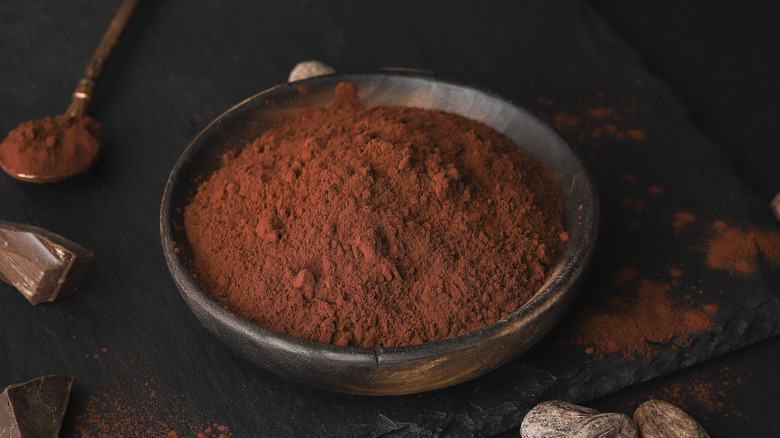Are Black And Dark Chocolate Cocoa The Same Thing?
Even if you love to bake, chances are you probably haven't thought that much about cocoa powder. That is, you don't think about it until you find a recipe that calls for something specific, like black cocoa powder. This super dark, chocolatey ingredient is somewhat new to the home-baking scene, but it's actually been around for a long time as the starring ingredient in one of the world's most-loved sandwich cookies: Oreos. You might be tempted to swap out whatever cocoa powder you have hanging around in the pantry for black cocoa, but depending on the recipe, it's worth taking the time to find the real thing. All cocoa powders might seem the same (or at least look similar) at first glance, but they're actually quite different in terms of taste, color, and composition.
All cocoa powder is made from the same cocoa beans, so the difference isn't the source of the cocoa powder itself. It all comes down to how each powder is created. Both black cocoa and dark cocoa are created using something called "Dutch processing," but black cocoa is Dutch-processed to the max, which creates a deep, dark chocolate flavor and color — perfect for something unique like a black forest cake. On the other hand, natural cocoa powder is different from these varieties because, as the name suggests, it's not processed.
What is Dutch processing?
Unless you're a pastry chef or an experienced baker, you probably only keep one kind of cocoa powder in your kitchen cabinet, and it's probably a Dutch-processed variety. That's because Dutch processing makes cocoa powder taste simpler by lowering the cocoa beans' natural acidity so that only a rich, full chocolate flavor is left behind. If you're not sure, check the label, which should list "Dutch-processed" right on the front; if not, your cocoa powder is almost certainly the natural variety.
The method for making Dutch-processed cocoa is simple: Cocoa beans are hulled and roasted to become "nibs," then they're ground into a paste. A machine squeezes out all the cocoa butter, and what's left behind is dried and ground into powder. For natural cocoa powders, the process stops there, which leaves the natural, fruity-tasting acidity of the cocoa nibs in place. Dutch-processed varieties, on the other hand, are treated with potassium carbonate to lower the acidity and reduce those fruity qualities so that the powder tastes more like plain, straightforward chocolate. Black cocoa, however, is alkalized again using a different method, which turns the color that deep, dark, brown-to-black color and intensifies the flavor. Again, think of the flavor of an Oreo cookie wafer, which is an intense, almost-burnt dark chocolate flavor.
What to know when swapping cocoa powders in recipes
Now, if you're making a recipe at home and you don't have any black cocoa, don't panic. There are lots of cocoa powder substitutes out there that you can reach for, but it's also totally okay to sub regular dark cocoa for black cocoa if that's all you have on hand since they're both Dutch-processed. The only difference you'll notice is that your finished brownies, cookies, or cakes won't have that distinctive, very dark brown/black color or telltale dark chocolate flavor.
On the other hand, if you want to substitute black cocoa powder for dark or natural cocoa, remember that black cocoa powder has low acid while natural cocoa powder has high acid, which will affect the leavener and thus the rise of your bake. A good rule of thumb is to use natural cocoa powder with recipes that have baking soda (sodium bicarbonate, which is basic), and Dutch-processed varieties (including black) with recipes that call for baking powder, which is double-acting and contains both sodium aluminum sulfate (basic) and calcium acid phosphate (acid). Black cocoa will also intensify the color and flavor of your cakes and cookies, so save it for recipes where you really want some extra oomph. In most cases, regular dark cocoa will do just fine, or you can use a blend of the cocoa powders to get the best of both worlds.


